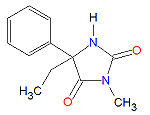Mephenytoin
|
| |||||||
| mephenytoin | |||||||
| |||||||
| Uses: | anti-seizure drug | ||||||
| Properties: | |||||||
| Hazards: | |||||||
| |||||||
Mephenytoin (Mesantoin®) is an anticonvulsant medication used to treat epilepsy and it is particularly effective in tonic-clonic epilepsy . Its common chemical name is 3-methyl 5,5-phenyl-ethyl-hydantoin and its IUPAC chemical name is 5-ethyl-3-methyl-5-phenylimidazolidine-2,4-dione. It has pharmacological effects similar to phenytoin and the barbiturates.
Mechanism of action
The mechanism of action of mephenytoin is not definitely known, but extensive research strongly suggests that its main mechanism is to block frequency-, use- and voltage-dependent neuronal sodium channels, and therefore limit repetitive firing of action potentials.[1]
Synonyms and brand names
Synonyms
- Mephentoin
- Methyl Hydantoin
- Methylphenetoin
Brand Names
- Epiazin®
- Gerot-Epilan®
- Insulton®
- Mesdontoin®
- Mesontoin®
- Methoin®
- Metydan®
- Phenantoin®
- Sacerno®
- Sedantional®
- Sedantoin®
- Sedantoinal®
- Triantoin®
External links
Mephenytoin - FDA approved drug information (drug label) from DailyMed (U.S. National Library of Medicine). Template:MedMaster Template:DrugBank
References
- ↑ DrugBank page for Mephenytoin. Retrieved on 062508.
